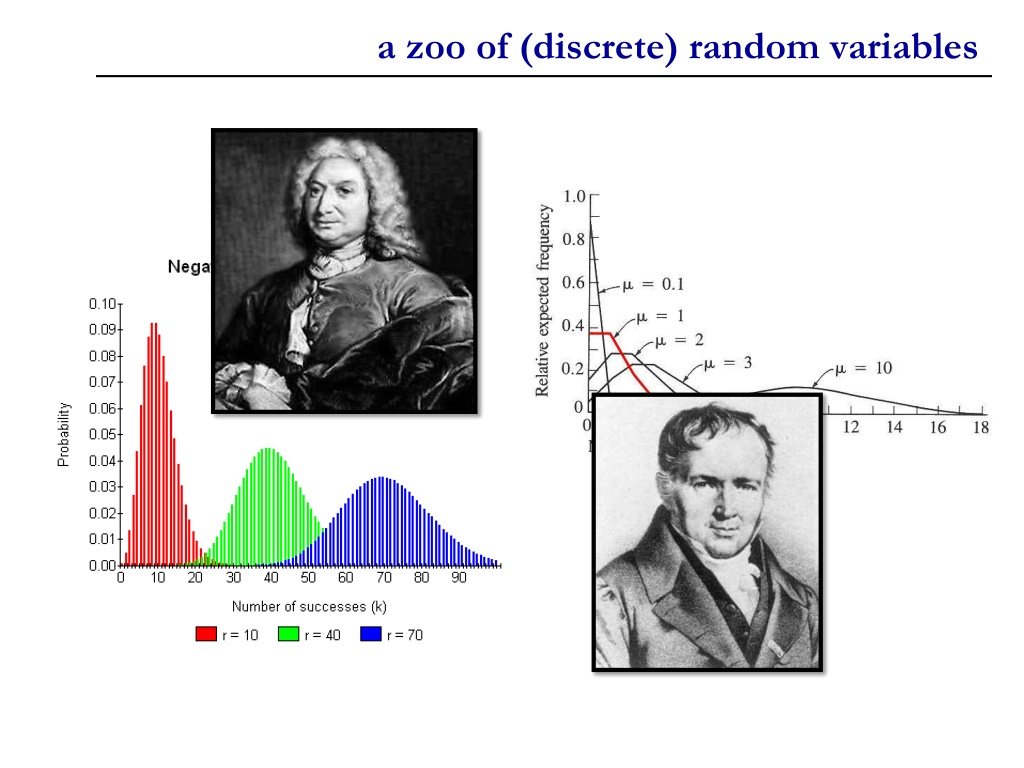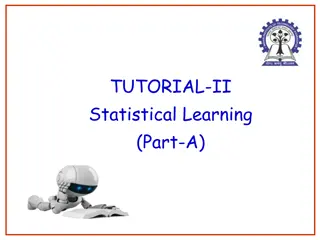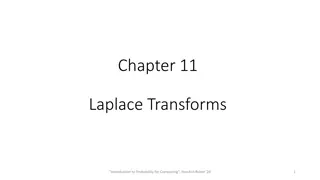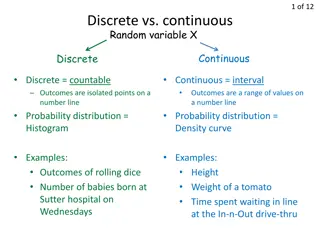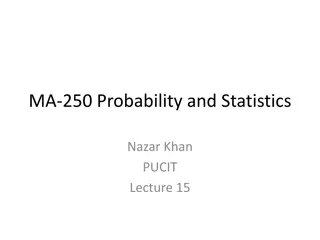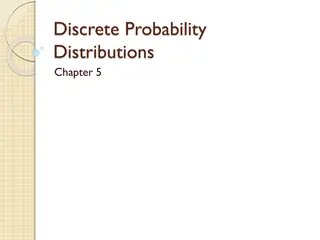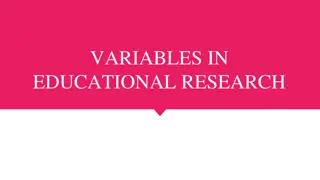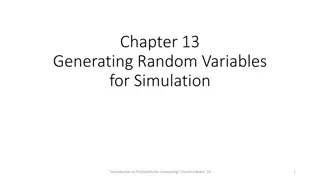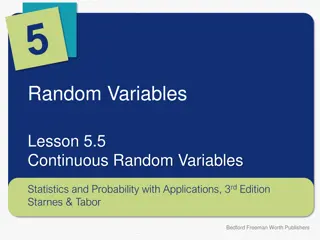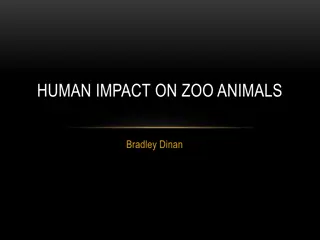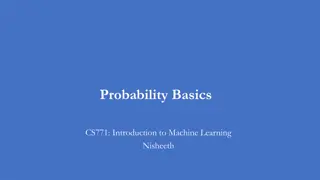Understanding a Zoo of Discrete Random Variables
Discrete random variables play a crucial role in probability theory and statistics. This content explores three key types: Bernoulli random variable, binomial random variable, and error-correcting codes. From understanding the basics of Bernoulli trials to exploring the application of error correction in data transmission, this information provides insight into various scenarios involving discrete random variables.
Download Presentation

Please find below an Image/Link to download the presentation.
The content on the website is provided AS IS for your information and personal use only. It may not be sold, licensed, or shared on other websites without obtaining consent from the author. Download presentation by click this link. If you encounter any issues during the download, it is possible that the publisher has removed the file from their server.
E N D
Presentation Transcript
bernoulli random variable Experiment results in Success or Failure X is a random indicator variable (1=success, 0=failure) P(X=1)=p and P(X=0)=1-p X is called a Bernoulli Bernoulli random variable: X ~ Ber(p) E[X] = p Var(X) = E[X2] (E[X])2 = p p2 = p(1-p) Examples: coin flip random binary digit whether a disk drive crashed
binomial random variable Consider n independent trials of a Ber(p) random variable X is number of successes in n trials X is Binomial Binomial random variable: X ~ Bin(n,p) By Binomial theorem, Examples # of heads in n coin flips # of 1 s in a randomly generated length n bit string # of disk drive crashes in a 1000 computer cluster
error correcting codes The Hamming(7,4) code Have original 4-bit string to send over the network Add 3 parity bits, and send 7 bits total If bits are b1b2b3b4 then the three parity bits are parity(b1b2b3), parity(b1b3b4), parity(b2b3b4) Each bit is indepednently corrupted (flipped) in transition with probability 0.1 X = number of bits corrupted ~ Bin(7, 0.1) Parity bits of the hamming code allow us to correct at most 1 bit error P(a correctable message received) = P(X=0) + P(X=1)
error correcting codes Using error-correcting codes: X ~ Bin(7, 0.1) P(X=0) + P(X=1) 0.8503 What if we didn t use error-correcting codes? X ~ Bin(4, 0.1) P(correct message received) = P(X=0) Using error correction improves reliability by 30% !
defective stereos A stereo consists of n components, each of which will fail independently with probability p. The stereo can still operate effectively if at least one-half of its components function. For what values of p is a 5-component system more likely to operate effectively than a 3-component system? X5 = # failed in 5-component system ~ Bin(5, p) X3 = # failed in 3-component system ~ Bin(3, p)
defective stereos X5 = # failed in 5-component system ~ Bin(5, p) X3 = # failed in 3-component system ~ Bin(3, p) Pr(5 component system effective) = Pr(3 component system effective) = Calculation: Calculation: 5-component system is better if and only if p > 1/2
properties of Bin(n,p) X ~ Bin(n,p) E[X] = pn (linearity of expectation) E[X2] = n + p2 n(n-1) (we did this calculation last time in the searches/servers problem, where we got 100 + 99 100/102) Var[X] = E[X2] (E[X])2 = np(1-p)
independence Two events E and F are independent if P(EF) = P(E) P(F) equivalently: P(E|F) = P(E) otherwise, they are called dependent Three events E, F, G are independent if P(EF) = P(E)P(F), P(EG) = P(E)P(G), P(FG) = P(F)P(G) and and P(EFG) = P(E) P(F) P(G) Example: Example: Let X, Y be each {-1,1} with equal probability E = {X = 1}, F = {Y = 1}, G = { XY = 1} P(EF) = P(E) P(F), P(EG) = P(E) P(G), P(FG) = P(F) P(G) but P(EFG) = 1/4 P(EFG) = 1/4 !!! (because P(G|EF) = 1)
independence In general, events E1, E2, , En are independent if for every subset S of {1,2, , n}, we have Theorem: E, F indepednent ) Proof: P(EFc) = P(E) P(EF) = P(E) P(E) P(F) = P(E) (1-P(F)) = P(E) P(Fc) ) E, Fc independent
independence In general, events E1, E2, , En are independent if for every subset S of {1,2, , n}, we have Theorem: E, F independent ) ) E, Fc independent Fact: E, F independent $ P(EF) = P(F) P(E|F) $ P(E|F)=P(E) $ $ P(F|E) = P(F)
biased coin Biased coin comes up heads with probability p. P(heads on n flips) = pn P(tails on n flips) = (1-p)n P(exactly k heads in n flips)
hashing m strings are hashed (uniformly) into a hash table with n buckets Each string hashed is an independent trial E = at least one string hashed to first bucket What is P(E) ? Solution: Fii = string i not hashed into first bucket (i=1,2, ,m) P(Fi) = 1 1/n = (n-1)/n for all i=1,2, ,m Event (F1F2 Fm) = no strings hashed to first bucket P(E) = 1 P(F1F2 Fm) = 1 P(F1) P(F2) P(Fm) = 1 ((n-1)/n)m
hashing m strings are hashed (non-uniformly) into a hash table with n buckets Each string hashed is an independent trial, with probability pi of getting hashed to bucket i E = At least 1 of buckets 1 to k has 1 string hashed to it What is P(E) ? Solution: Fii = at least one string hashed into i-th bucket P(E) = P(F1[ [ [ [Fk) = 1-P((F1[ [ = 1 P(F1cF2c Fkc) = 1 P(no strings hashed to buckets 1 to k) = 1 (1-p1-p2- -pk)m [ [Fk)c)
network failure Consider the following parallel network p1 p2 pn n routers, each with probability pi of failing independently P(there is functional path) = 1 P(all routers fail) = 1 (1-p1)(1-p2) (1-pn)
DNA paternity testing Child is born with (A,a) gene pair (event BA,a) Mother has (A,A) gene pair Two possible fathers: M1 = (a,a), M2 = (a,A) P(M1) = p, P(M2) = 1-p What is P(M1 | BA,a) ? Solution:
deeper into independence Recall: Two events E and F are independent if P(EF) = P(E) P(F) If E and F are independent, does that tell us anything about P(EF|G) = P(E|G) P(F|G), when G is an arbitrary event? In general, no.
deeper into independence Roll two 6-sided dice, yielding values D1 and D2 E = { D1 = 1 } F = { D2 = 6 } G = { D1 + D2 = 7 } E and F are indepenent P(E|G) = 1/6 P(F|G) = 1/6 P(EF|G) = 1/6 so E|G and F|G are not independent!
do CSE majors get fewer As? Say you are in a dorm with 100 students 10 of the students are CS majors: P(CS)=0.1 30 of the students get straight A s: P(A)=0.3 3 students are CS majors who get straight A s P(CS,A) = 0.03 P(CS,A) = P(CS) P(A), so CS and A independent At faculty night, only CS majors and A students show up So 37 students arrive Of 37 students, 10 are CS ) Seems like being CS major lowers your chance of straight A s Weren t they supposed to be independent? In fact, CS and A are conditionally dependent at faculty night ) P(CS | CS or A) = 10/37 = 0.27
explaining away Say you have a lawn It gets watered by rain or sprinklers P(rain) and P(sprinklers) are independent You come outside and see the grass is wet. You know that the sprinklers were on Does that lower the probability that it rained? This is phenemon is called explaining away One cause of an observation makes another cause less likely Only CS majors and A students come to faculty night Knowing you came because you re a CS major makes it less less likely you came because you get straight A s
conditioning can also break DEPENDENCE Consider a randomly chosen day of the week A = { It is not a Monday } B = { It is a Saturday } C = { It is the weekend } A and B are dependent events P(A) = 6/7, Now condition both A and B on C: P(A|C) = 1, P(AB|C) = P(A|C) P(B|C) ) P(B) = 1/7, P(AB) = 1/7. P(B|C) = , P(AB|C) = ) A|C and B|C independent Dependent events can become independent by conditioning on additional information!
conditional independence Two events E and F are called conditionally independent given G, if P(EF|G) = P(E|G) P(F|G) Or, equivalently, P(E|FG) = P(E|G) Now condition both A and B on C: P(A|C) = 1, P(AB|C) = P(A|C) P(B|C) ) P(B|C) = , P(AB|C) = ) A|C and B|C independent Dependent events can become independent by conditioning on additional information!
